
Over the weekend, Business Spectator’s Rob Burgess posted an article strongly supporting his boss, Rupert Murdoch’s, plea that Australia maintain its high immigration intake, while lambasting those whom question the merits of such policy:
[Rupert Murdoch] addressed two points that have been misused as political weapons in the past four years.
First, he reiterated his belief that Australia should continue a robust immigration program. To demographers and economists, that’s a no-brainer. However, with the complicty of the ‘he-said-she-said’ style of journalism Australians have become too comfortable with, this was seriously raised as a problem at the 2010 election.
At that time, both sides of politics (afraid of losing the xenophobe vote) paid lip service to the idea that Big Australia was something to fear (The invention of cloud campaigning, July 2010).
Thankfully we were spared such silliness at the 2013 election. With Labor’s silly campaign handing power to Tony Abbott on a platter, there was no time to even broach the topic…
He is right to… celebrate immigration as an important lifeblood of the nation.
That Burgess has gone into bat for his boss and argued for an ever-growing population is understandable. After all, more people means more potential users of Murdoch’s various media assets, and more profits to be had.
But Burgess’ claim that to question high immigration is either silly or xenophobic is economic hogwash.
As regular readers will know, I have been a long-time skeptic of Australia’s high immigration policy, which is running at roughly double historical norms (see next chart). While expanding Australia’s population by more than 1 million people every three years might be great for Australia’s business elites – who enjoy the fruits of an expanded market – it imposes real costs on the rest of us, who must endure increased costs of congestion, higher infrastructure costs, lower environmental amenity, and minimal uplift in material economic well-being.
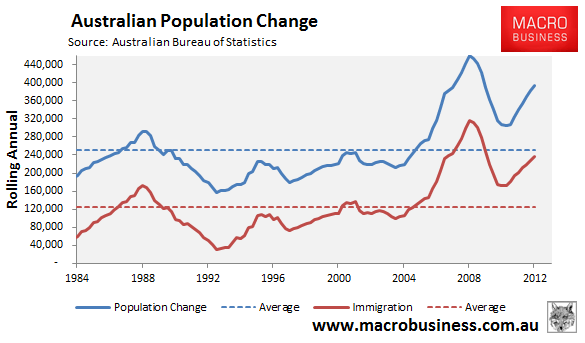
Below is my critique of the view that high population growth (based primarily on immigration) is unambiguously beneficial for Australia. These arguments have been articulated previously, therefore, apologies if you have read them before.
Population growth and the economy:
Advocates of population growth argue that it is required in order to grow the economy and that, without it, growth would suffer, lowering overall living standards.
However, from a narrow economic perspective, population growth (immigration) is good only if it raises the real incomes of the pre-existing population (e.g. GDP per capita). While it is true that Australia’s high population growth over the second half of the 2000s boosted Australia’s real GDP (more labour inputs, other things equal, means more outputs), evidence is sketchy as to whether GDP per capita increased due to population growth. In fact, as the below chart shows, real GDP per capita has remained lacklustre since 2007, suggesting that while the overall economic pie has increased in size because of high population growth, everyone’s share of that pie has barely grown.
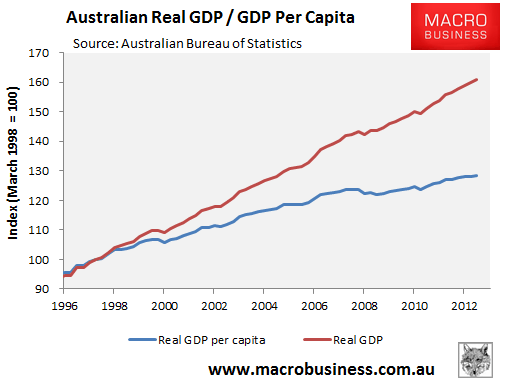
The economic impact of ongoing high immigration is also illustrated by the next chart, which shows population growth’s contribution to headline GDP, and how growth in per capita terms has been lacklustre ever since the Global Financial Crisis, with Australia experiencing a recession in per capita terms in 2008:
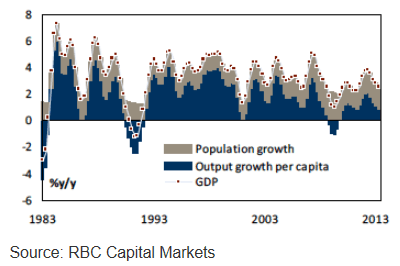
Of course, we don’t know the counter-factual. Growth in per capita GDP might have been worse (or better) without such strong immigration. But the arguments for (or against) high rates of immigration purely on narrow economic grounds is inconclusive.
Population growth, infrastructure and productivity:
The question around living standards becomes more important when infrastructure constraints and the environment are taken into account.
Indeed, a big negative of Australia’s high rate of population growth is that it is placing increasing pressure on the pre-existing (already strained) stock of infrastructure and housing, which reduces productivity and living standards unless costly new investments are made. Further, controversial investments like desalination plants would arguably not have been required absent such population growth.
Further, when infrastructure and housing investment fails to keep up, it places upward pressure on inflation, requiring higher interest rates, which can then damage productive sectors of the economy. As explained in a 2011 speech by the Reserve Bank of Australia’s Phil Lowe (summarised here), these factors were certainly in play in the late-2000s, when rapid population growth placed upward pressure on rents, as well as caused a big surge in utilities prices as the capacity of the system struggled to keep pace with the growing demand, requiring costly new investments.
Ongoing high population growth also places additional strain on the natural environment, causing greater environmental degradation, increasing water scarcity and pollution, and making it more difficult for Australia to reduce its carbon footprint and meet international pollution reduction targets.
We need immigration to ameliorate the affects of an aging population?
Another common argument from proponents of high immigration is that it is required in order to mitigate the aging of Australia’s population.
The United Nations forecasts that the ratio of workers to dependents in Australia is projected to fall significantly over coming decades as the Baby Boomer generation retires en masse (see next chart).
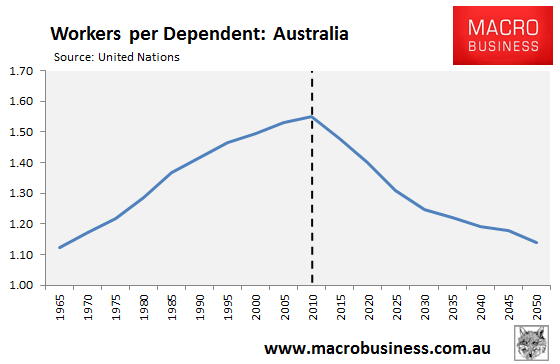
However, the argument that Australia can avoid (rather than delay) population aging is spurious. The issue of an aging population will need to be addressed at some point irrespective of the level of immigration. Simply importing more workers to cover the retirement of the Baby Boomers only delays the aging problem, pushing the problem onto future generations. Further, what will be the solution in 30 years time when current migrants grow old, retire and need taxpayer support? More immigration and an even larger Australia?
While the current population growth rate of 1.8% seems fairly benign, due to the powers of compounding, such a rate of growth is clearly unsustainable over a long time frame (see next chart).
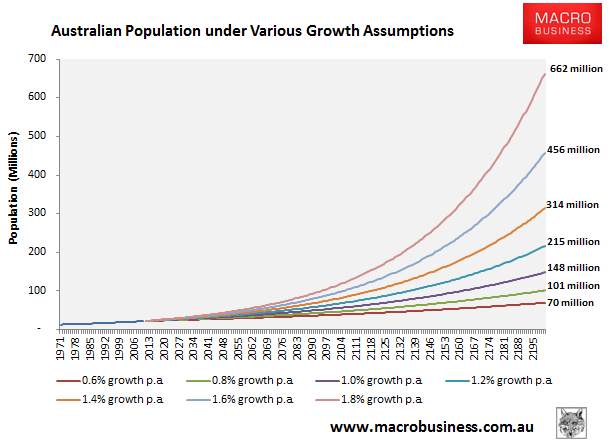
While the above chart may seem facetious, as population growth could be curtailed at some point in the future, the fact remains that there will always be vested interests pressuring governments to expand population growth in the face of an ever-aging population. Hence, boosting immigration to overcome an aging population is no solution at all.
A free kick to rent-seekers:
Why, then, are Australia’s politicians continuing to follow the high immigration path when the benefits to the pre-existing population are so questionable?
Well, apart from juicing headline GDP growth and delaying the impact of an aging population (explained above), high immigration appeases big business.
Australia is ruled by duopolies and oligopolies, which see a rising population as an easy way of selling more goods and services. Big business also receives, through immigration, access to lower cost workers. And there’s less need to become more efficient when your customer base is growing inexorably. Rather, just sit back and watch the profits flow.
Take, for example, Australia’s banks, which get the double bonus of not just having more consumers to sell debt to, but also extra demand for housing, which helps to support house prices and their loan collateral, especially given the urban consolidation policies operated by Australia’s states.
However, while the big end of town is the clear winner from rapid population growth, it doesn’t wear many of the costs. That is borne by you and I.
As argued many times previously, while I believe that Australia could probably support a substantially larger population with improved policy settings and investment, like many Australians, I don’t hold much faith in our political class or policy making processes, which have time and again proven to be deficient in providing adequately for the pre-existing population (let also tens of millions more people), or that a substantially larger population would improve living standards anyway.
I challenge commentators, like Rob Burgess, to counter my arguments and articulate why high immigration is unambiguously beneficial for ordinary Australians. Given high immigration is supposedly a “no brainer”, they shouldn’t have too much trouble drafting their response.

